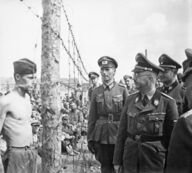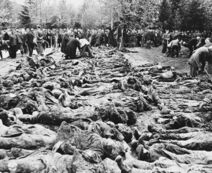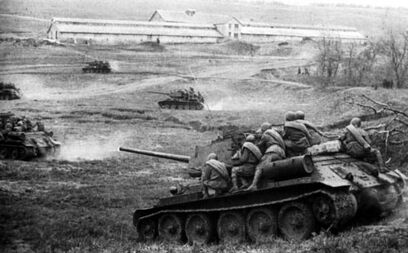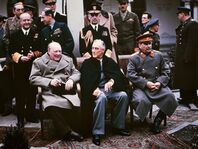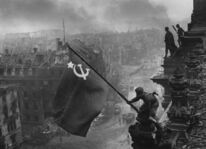Soviet Union in World War II
Heinrich Himmler locks eyes with a Soviet prisoner of war in Russia or Belarus, c. 1941.
Soviet POWs massacred by Germans in April 1945 in the face of Soviet advance. This image apparently shows the bodies being reburied.
Soviet tanks near Odessa, c. April 1944, during the liberation of Ukraine.
Churchill, FDR, and Stalin discuss the future of postwar Europe at the Yalta Conference in Crimea, February 1945.
A Soviet soldier raises the flag of the Soviet Union over the Reichstag building, 2 May 1945.The Soviet Union was an integral part of the causes, nature, and outcome of the Second World War.
Background
Anti-communism
The Second World War was in many ways a confrontation between fascism, liberal capitalism, and communism, and the latter had no better representative than the Soviet Union.
The 1917 Russian Revolution brought about the first successful proletarian government. Bourgeois forces, including the United Kingdom, the United States, France, and Japan, failed in their attempts to suppress this government during the Russian Civil War, allowing the Russian communists to consolidate their territory into the Russian Soviet Federative Socialist Republic, later known as the Union of Soviet Socialist Republics. The USSR's support for communist and socialist movements throughout Eurasia posed a threat to the capitalist-imperialist state of affairs, triggering finance capitalists in Germany, Italy, and elsewhere to support the installation of fascists and fascistic groups as the only effective opponent to the communist threat. In addition, non-fascist capitalist states implicitly tolerated or even supported the growth of fascist movements in Europe. Prince Edward of the UK, for example, had good relations with the National Socialist leadership into the late 1930s and spoke privately of his strong sympathies with their cause, and there is evidence that the Nazi government intended to reinstall him as king upon a Nazi invasion of Great Britain.[1][2] Hitler and Mussolini also had influential sympathizers in the United States.[citation needed] Chancellor of the Exchequer and future PM Winston Churchill visited Fascist Italy several times during the 1920s and expressed open admiration for Mussolini as a "Roman genius" and fascism itself as "the necessary antidote to the Russian poison".[citation needed]Even opponents of fascism in other factions of the capitalist and aristocratic classes of these countries typically supported a general confrontation between fascism and communism which would result in their mutual annihilation.[citation needed] This general tenor among reactionary and imperialistic sections of the ruling class was the background for the later policy of appeasement.
Imperialism
Fascism, as a reformulation of bourgeois nationalism, inherited and carried out many of the same objectives of the preceding bourgeois governments. This included the expansionist tendencies of the German Empire, which became overtly expressed in the Nazi ideology of Lebensraum, an emphasis on rearmament and war, and the racial inferiority of Slavic peoples. In fact, this restatement of old imperialism in new clothes was arguably the cause of the conflict between anti-communist bourgeois unity and inter-imperialist rivalry, which proved one of the most important contradictions in determining the progress of the war. As the Nazis consolidated power in Germany, Churchill and other British imperialists came to view fascist expansion and the threat it posed to British hegemony as a more immediate threat than Bolshevism. This anti-fascist faction of the bourgeoisie won out by 1940. It has been argued that this was thanks in part to the strategic alliance that the Soviets would pursue with the Axis powers.[citation needed]
Prelude
Appeasement
Molotov–Ribbentrop Pact
After the Munich Agreement, the Soviet Union pursued a rapprochement with Nazi Germany. On 23 August 1939 the Soviet Union signed a non-aggression pact with Germany which included a secret protocol that divided Eastern Europe into German and Soviet spheres of influence, anticipating potential "territorial and political rearrangements" of these countries.
Neutral phase (1939–1941)
Invasion of Poland
Katyn affair
Baltic states
German invasion
Operation Barbarossa
Fall Blau
Final phase
Invasion of Germany
Soviet invasion of Manchuria
Aftermath
Reconstruction
Fate of POWs
Economy and society
Industrial output
Propaganda
Military
The Soviet Union quickly adapted its military doctrine and strategy to changing conditions as the Germans carried out the largest land invasion in human history.
Myths abound in non-Russian speaking cultures, especially in the Anglophone world, which portray excessive brutality on the part of Red Army leadership. Practices such as shooting retreating soldiers en masse and the use of one rifle for every two soldiers are portrayed in historical fiction such as the 2001 film Enemy at the Gates and video games in the Call of Duty series.[3]
Postwar historiography relied heavily on the memoirs of Wehrmacht general Kurt von Tippelskirch[citation needed] which claimed that the Soviets had outnumbered the Nazis 7 to 1 and had a loss ratio of 10 to 1.[citation needed] In fact, the loss ratio was much closer.[citation needed]
Tactics
Logistics
Soviet logistics were instrumental in winning the war against Germany. While logistical support did break down in rare cases, especially during the chaotic early months of the war, most Red Army regulars were well-equipped by the end of the German incursion and did not typically lack rifles or other basic supplies. Supply deficiencies also occurred among the irregular and quickly-formed Narodnoe Opolcheniye, or "People's Militias".[citation needed] Fighters at Stalingrad and elsewhere did not face such supply shortages and in fact, the USSR outproduced Germany: in aircraft by a factor of 1.3, tanks by 1.7, machine guns by 2.2, artillery by 3.2 and mortars by 5.5.[4]
Blocking detachments
The Soviet Army instituted blocking detachments (zagraditelnye otriady) in certain penal battalions and rarely executed retreating soldiers, typically after a trial.[citation needed]
Military executions
German POWs
Rape
Notes
References
- ↑ Burack, Emily (5 Jan 2023). "The British Royal Family's Connection to the Nazis". Town & Country. Retrieved 24 Sep 2023.
- ↑ Ruz, Camila; Low, Harry (20 Jul 2015). "What is the context of the royal 'Nazi salute' film?". BBC News. Retrieved 24 Sep 2023.,
- ↑ For instance, "Not One Step Back", from Call of Duty: Finest Hour.
- ↑ Richard Overy, Why the Allies Won; Chris Chant, Small Arms
